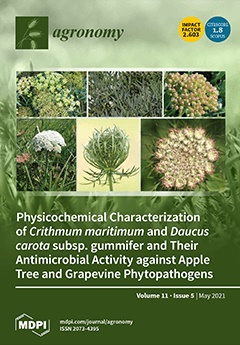View Item
- xmlui.general.dspace_homeCentros Regionales y EEAsCentro Regional Buenos Aires SurEEA Hilario AscasubiArtículos científicosxmlui.ArtifactBrowser.ItemViewer.trail
- DSpace Home
- Centros Regionales y EEAs
- Centro Regional Buenos Aires Sur
- EEA Hilario Ascasubi
- Artículos científicos
- View Item
Spontaneous Gene Flow between Cultivated and Naturalized Vicia villosa Roth Populations Increases the Physical Dormancy Seed in a Semiarid Agroecosystem
Abstract
Hairy vetch (Vicia villosa Roth) is the second most cultivated vetch worldwide being used as a forage and cover crop. As it is not domesticated, it displays several wild traits including seed dormancy. The physical seed dormancy (PY) variation could be useful depending on the specific context. High PY is desirable for ley farming systems, while low PY is needed to prevent weediness in subsequent crop rotations. Gene flow between cultivated and naturalized
[ver mas...]
Hairy vetch (Vicia villosa Roth) is the second most cultivated vetch worldwide being used as a forage and cover crop. As it is not domesticated, it displays several wild traits including seed dormancy. The physical seed dormancy (PY) variation could be useful depending on the specific context. High PY is desirable for ley farming systems, while low PY is needed to prevent weediness in subsequent crop rotations. Gene flow between cultivated and naturalized populations has important ecological and agronomic consequences. Experiments were conducted to determine the change in the level of PY in spontaneous crosses between European cultivated accessions (EU) characterized by low PY and naturalized Argentinian population (AR) with high PY. Generations G0 (initial generation) to G3 were assessed for their PY in seeds and total dry matter (DM) per plot, at plant maturity. As the result of spontaneous crosses with the AR population, an increase from G0 to G3 in PY and DM in EU accessions was observed, while AR maintained its high PY and DM values. In one mating cycle, selecting for PY lower than 14% and high DM can satisfy breeding objectives for cover crops. Isolation during breeding and seed production is necessary to avoid gene flow. This knowledge extends to other legume species with gene flow between wild and cultivated populations.
[Cerrar]

Author
Fuente
Agronomy 11 (5) : 955 (May 2021)
Date
2021-05
Editorial
MDPI
ISSN
2073-4395
Documentos Relacionados
Formato
pdf
Tipo de documento
artículo
Proyectos
(ver más)
INTA/2019-PE-E6-I142-001/2019-PE-E6-I142-001/AR./Mejoramiento genético de leguminosas y gramíneas forrajeras para incrementar la productividad y la sustentabilidad de los sistemas agropecuarios de la Argentina
Palabras Claves
Derechos de acceso
Abierto
 Excepto donde se diga explicitamente, este item se publica bajo la siguiente descripción: Creative Commons Attribution-NonCommercial-ShareAlike 2.5 Unported (CC BY-NC-SA 2.5)
Excepto donde se diga explicitamente, este item se publica bajo la siguiente descripción: Creative Commons Attribution-NonCommercial-ShareAlike 2.5 Unported (CC BY-NC-SA 2.5)


